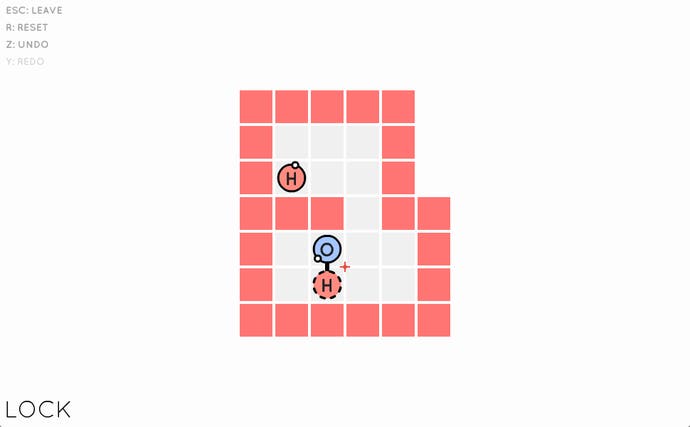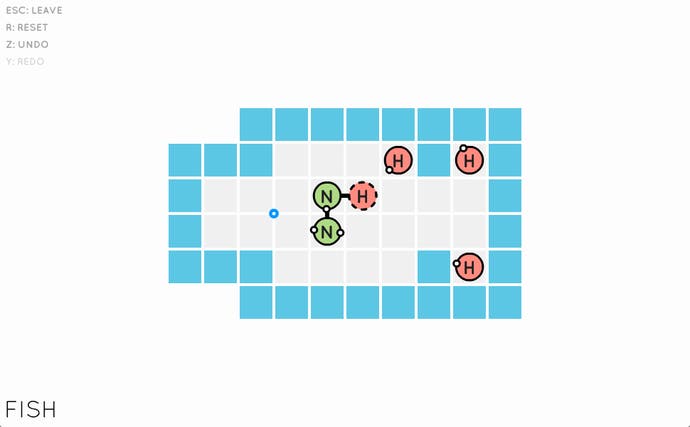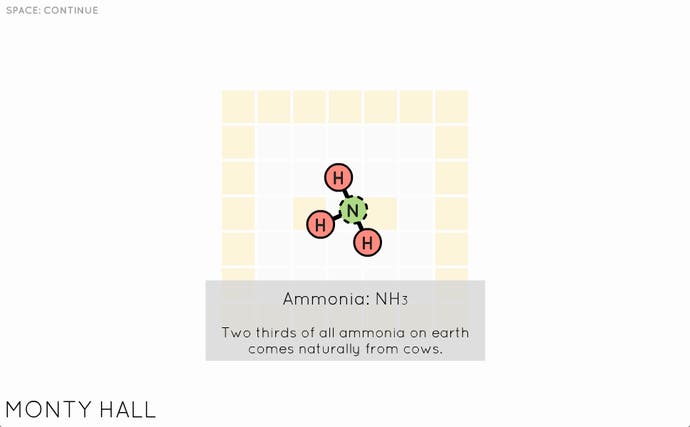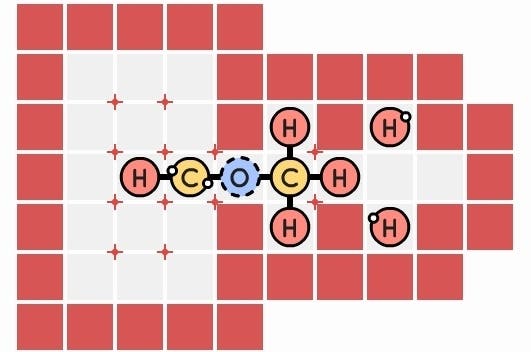Sokobond review
Breaking bond.
To me, the best puzzle games feel like they've been discovered, not designed. Like they've always been there, waiting for someone to come along and uncover them. In the world of puzzle games, developers like Drop7 co-creator Frank Lantz are scientists or explorers, unearthing perfect gems which shine with a complexity that unfurls from a set of simple rules which, once you've grasped them, feel like natural laws. Sokobond is one of these puzzle games - and fittingly, when you start playing it, it feels like a game you've discovered, too.
That's because you learn it without tortuous tutorials. It opens without explanation, just the opportunity to play and experiment. Three circles are sitting on a board of squares. Two of them are red, each with an H displayed in its middle and with a single little orb orbiting it, and one is a blue O with two orbs. One of the Hs bears a dotted rather than solid circle and you can move it around the board with the cursor keys. Soon enough, you learn that if you move a circle next to another and they both have orbs, they'll bond together and an orb will disappear from each. A few moves later, you'll have manoeuvred each circle into a cluster and discovered that the object is to remove all the orbs, leaving you with a little structure.

I don't know much about chemistry, but I guess some of you will have immediately worked out what Sokobond is really about. The circles represent atoms - the H circles are hydrogen, the O is oxygen, and when you've put them all together you've made water: H2O. Perhaps this is why the game feels so elemental, if you'll forgive the pun. It plays upon the rules of the elements, and in each level you'll be making a molecule, from hydroxylamine (NH2OH) to ethanol (C2H6O), their configurations defined by the number of bonds the atoms can carry.
But don't worry if all this sounds boring. The science stuff really doesn't matter beyond giving Sokobond an incredibly solid logical bedrock. And if you're thinking it sounds like SpaceChem, it isn't that either. Both games are based on chemistry, but while SpaceChem focuses on making programs or systems, Sokobond is actually a far simpler and more immediate puzzle game that's descended from Sokoban, the block-sliding classic, because much of the puzzle challenge lies in making molecules fit together in confined and awkward spaces.
I think it's even better than Sokoban, for several reasons. First, this is one of those delicious puzzle games where you'll find yourself sketching solutions to help you through a level. The first time I did it was with a level that had two four-bond carbons, two two-bond oxygens and four single-bond hydrogens. That's a lot of atoms to track, but the way it should fit together derives from those orbs - work it out and you'll know just what shape you're aiming for. I'll admit that my execution was a lot messier.

I love the way that each level involves different tiers of thinking; truth be told, I kind of hate sliding puzzle games because I find them so samey and strict. But Sokobond levels are fluid. Maybe you'll try to visualise the formation you need to produce before you work out how to make it: one level called Chimney has a single-bonded hydrogen atom placed right up the end of a narrow alley, so you know you need to form a rod with the other atoms to access it. Sometimes you'll experiment first and see if the formation makes itself evident. Either way, you get that lovely sense of steadily evolving comprehension as you feel out where the challenges are and strip down the possibility space, bringing what initially seems impossibly complex under control. Sokobond's chemistry is organic in the best kind of way.
It's also better than good old Sokoban because it's far more varied. Sokobond is divided into sets themed on different mechanics. The first set introduces you to the concept of bonding; the next brings in a bond cutter, which divides molecules if you move their bonds over it. Further on there's a bond doubler, which uses an extra couple of orbs if they're available on adjacent atoms. There's a rotation element, which can change a molecule's shape if its form allows. In one level these mechanics will be part of the solution, allowing you to manipulate your atoms with greater flexibility, and in another they'll provide its core challenge, cutting a bond just when it looked like you had it solved.

Adding to this constantly shifting nature is the design of Sokobond's gridded level menu, which gives you a good deal of freedom over which levels you can choose to play. Rather than presenting them as a linear succession, solving a level unlocks the adjacent ones within the same set; solve those levels marked with arrows pointing into a new set and you'll get access to them. Best of all, Sokobond never stoops to the all-too-common puzzle game sin of increasing the challenge by simply adding more atoms to wrangle. Even at its end, many of its levels are more or less as minimal as the early ones, but they pack a cognitive punch that affirms the design brilliance of its developers, the duo of Alan Hazelden and Harry Lee. (Lee also designed the excellent iPhone puzzler Stickets).
It's all supported by a peculiarly elegant attitude to structure and presentation that's established by clean visual design, smooth and subtle animations, and a soundscape of melodic chimes and soft clicks over a bed of low ambient chords. This approach continues in a generosity towards your fumblings through the levels themselves. While many puzzle games up the ante by featuring a step counter to shame your efforts, Sokobond happily sits back and lets you probe and test, fail and succeed. In fact, it gives you undo and redo keys so you can wipe away every error with no loss of dignity. It refuses to stand between you and the purity of its puzzles.
Sokobond is a beautiful game. It treats you as an equal, giving you the sense of achievement that comes with having worked out all its intricacies for yourself. It's innately pleasurable to interact with, and it's built upon a masterfully original game design that feels timeless - probably because its base rules are so fundamental. This is a game about the beauty of science, and most puzzle games can learn from its findings.

